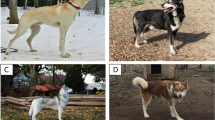Abstract
Breeders of purebred dogs usually have several goals they want to accomplish, of which canine wellbeing is one. The purpose of this article is to investigate what we ought to do given this goal. Breeders typically think that they fulfil their wellbeing-related duties by doing the best they can within their breed of choice. However, it is true of most breeders that they could produce physically and mentally healthier dogs if they switched to a healthier breed. There are a few breeds that are healthier than other breeds as well as mutts; we could maximize wellbeing for the next generations by focusing all our breeding resources on those. However, in the long run such a strategy would severely deplete the canine gene pool. If we are to breed for wellbeing in the long run, we must thus weigh the benefits of selection against physical and mental problems against the benefits of genetic diversity. The optimal breeding strategy for canine wellbeing is to preserve many breeds, though not all of them. Furthermore, we ought to combine strict health programs with looser barriers between breeds. Such a policy conflicts with the goal of breed preservation, at least if we think of breeds as populations registered within kennel clubs rather than types of dogs, but not with the goal of producing good working dogs capable of performing various tasks.
Similar content being viewed by others
Notes
A lot of what is said in this article could be generalized to the breeding of other companion animals. I will, however, focus solely on dogs throughout.
Or ‘prima facie’, as W D Ross put it. I prefer ‘pro tanto’, since the term ‘prima facie’ sometimes means ‘merely apparent’.
Obviously, there is a limit to how strict a health program realistically can be. Extremely strict programs would require vast amounts of expensive testing of breeding animals and their relatives, and the result might be that almost no dog is considered good enough. But it is, for instance, not unrealistic to breed only on dogs who are free from hip and elbow dysplasia; not if the breed barriers are loosened up.
Remember that I am only talking about breeding here; when it comes to training methods there might still be a conflict, since it might be the case that benevolent training methods require more resources, better trainers and/or take more time than crueller methods.
References
Buchanan, A. D. W., Brock, N. D., & Winkler, D. (2000). From chance to choice genetics and justice. Cambridge: Cambridge University Press.
Edwards, S. D. (2001). Prevention of disability on grounds of suffering. Journal of Medical Ethics, 27(6), 380–382.
Harman, E. (2004). Can we harm and benefit in creating? Philosophical Perspectives, 18, 89–113. (Ethics).
Haynes, R. P. (2008). Animal welfare competing conceptions and their ethical implications. Berlin: Springer.
Malmquist, E. (2008). Good Parents, Better Babies (doctoral dissertation). Linköping: Department of Medical and Health Sciences.
Nicholas, F. W. (1996). Introduction to veterinary genetics. Oxford: Oxford University Press.
Reindal, S. M. (2000). Disability, gene therapy and eugenics: A challenge to John Harris. Journal of Medical Ethics, 26(2), 89–94.
Savulescu, J. (2001). Procreative beneficence: Why we should select the best children. Bioethics, 15(5–6), 413–426.
Savulescu, J., & Bostrom, N. (Eds.). (2009). Human enhancement. Oxford: Oxford University Press.
Statistiska Centralbyrån, SCB (the Central Bureau of Statistics). Leading researcher: Daniel Persson. 2012. http://www.jordbruksverket.se/download/18.300b18bd13d103e79ef80002651/Resultatrapport+Hundar+katter+och+andra+s%C3%A4llskapsdjur+2012.pdf.
Svartberg, K. (2003). Personality in Dogs (doctoral dissertation). Stockholm: Stockholm University.
The Swedish Board of Agriculture (no author given). 20120-04-29. http://www.jordbruksverket.se/amnesomraden/djur/hundarochkatter/avel.4.207049b811dd8a513dc8000462.html.
The Swedish Kennel Club (no author given). 2012-03-14. Ethical guidelines. http://www.skk.se/uppfodning/regler-policys-och-lagar/skks-etiska-riktlinjer.
Wasserman, D. (2005). The nonidentity problem, disability, and the role morality of prospective parents. Ethics, 116(1), 132–152.
Woodward, J. (1986). The non-identity problem. Ethics, 96, 804–831.




